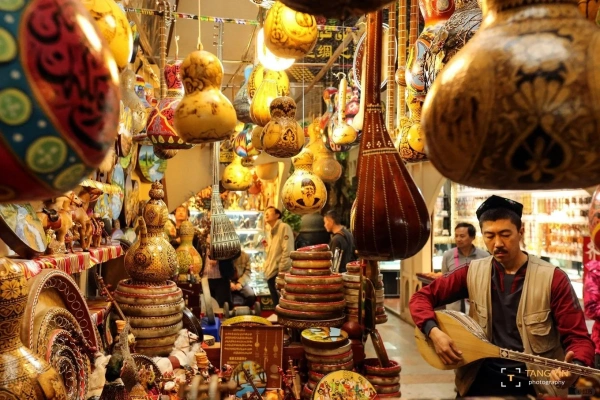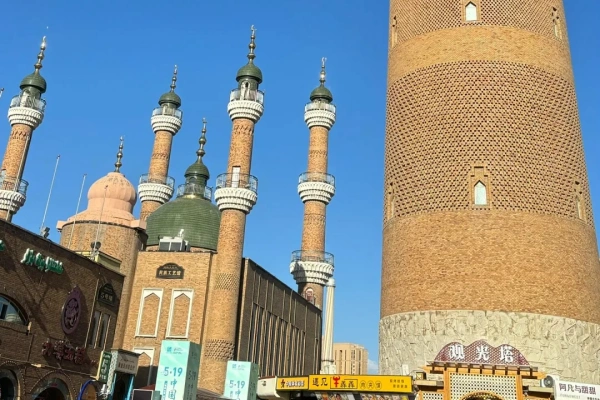Hotan Grand Bazaar
The Hotan Grand Bazaar is a bustling microcosm of Hotan's rich cultural heritage and economic vitality. It has been a focal point for trade, social interaction, and cultural exchange for centuries, attracting visitors from far and wide. This lively marketplace offers a sensory feast, with its vibrant colors, exotic aromas, and the constant hum of activity. It serves as a window into the traditional lifestyle of the local people and provides a unique opportunity to experience the essence of Hotan's culture.
Historical Overview
The Hotan Grand Bazaar has a long and storied history that dates back to ancient times. As a key node on the Silk Road, it played a crucial role in facilitating trade between the East and the West. Merchants from different regions would converge here, bringing with them a diverse array of goods, ideas, and cultures. Over the years, the bazaar has witnessed the rise and fall of empires, the ebb and flow of trade routes, and the evolution of local customs. Despite the passage of time, it has retained its traditional charm and continues to thrive as a center of commerce and cultural interaction.

Structural Layout
The bazaar is characterized by a well - organized structural layout that reflects the ingenuity of local architecture. It is divided into several distinct sections, each dedicated to a specific type of goods. There are areas for textiles, where you can find a dazzling array of colorful fabrics, from traditional Uyghur patterns to modern designs. The jewelry section is a treasure trove of precious stones and intricate silverware, showcasing the region's renowned craftsmanship. The food area is a haven for foodies, with stalls selling a variety of local delicacies, from fresh fruits and nuts to savory snacks and sweet treats. The layout is designed to facilitate easy navigation, allowing visitors to explore the bazaar at their own pace.
Major Attractions
Textile Treasures: The textile section of the bazaar is a must - visit for anyone interested in fashion and traditional crafts. Here, you can find a wide range of fabrics, including silk, cotton, and wool, in a kaleidoscope of colors and patterns. You can watch skilled artisans at work, weaving and embroidering beautiful pieces by hand. You can also purchase unique textiles to take home as souvenirs or to create your own one - of - a - kind garments.
Jewelry Galore: The jewelry stalls in the bazaar are a sight to behold. You'll find an exquisite collection of gold, silver, and gemstone jewelry, each piece meticulously crafted with traditional techniques. From elegant necklaces and bracelets to intricate earrings and rings, there's something to suit every taste and budget. You can even have custom - made jewelry designed according to your preferences, making it a truly personalized shopping experience.
Culinary Delights: The food area of the bazaar is a paradise for food lovers. Sample local specialties such as roasted lamb skewers, hand - pulled noodles, and jujube cakes. The aroma of freshly baked bread and the sight of colorful fruits and vegetables create an irresistible temptation. You can also try traditional Uyghur tea, which is brewed with a blend of herbs and spices, providing a refreshing and aromatic beverage.
Handicraft Haven: In addition to textiles and jewelry, the bazaar is also home to a variety of other handicrafts. You can find beautifully carved wooden items, delicate pottery, and colorful painted eggs. These handicrafts not only showcase the artistic skills of the local people but also serve as unique mementos of your visit to Hotan.
Suggested Itineraries
Short - and - Sweet Route (2 - 3 hours):
Start at the entrance of the bazaar and head straight to the textile section. Browse through the different stalls, admire the beautiful fabrics, and maybe purchase a small scarf or piece of cloth. Next, make your way to the jewelry area and take a look at the stunning pieces on display. Finally, end your visit with a stop at the food stalls for a quick snack or a cup of tea.
Highlights: Get a taste of the bazaar's main attractions in a short amount of time, focusing on textiles, jewelry, and food.
Half - Day Exploration (4 - 5 hours):
Begin your journey at the handicraft section, where you can spend some time exploring the unique wooden items, pottery, and other crafts. Then, move on to the textile area and spend more time selecting a special piece of fabric or clothing. After that, visit the jewelry stalls and try on some pieces to find the perfect accessory. Finally, relax and enjoy a proper meal at one of the food stalls or small restaurants in the bazaar.
Highlights: A more in - depth exploration of the bazaar, allowing you to appreciate the variety of handicrafts and have a more leisurely shopping and dining experience.
Full - Day Adventure (6 - 8 hours):
Start your day early and spend the morning exploring all the different sections of the bazaar in detail. Take your time to chat with the vendors, learn about the history and techniques behind the products, and haggle for the best prices. Have a light lunch at one of the food stalls and then continue your exploration in the afternoon. You can also visit some of the nearby workshops to see how the artisans create their masterpieces. In the evening, enjoy a cup of tea and watch the bazaar come alive with the evening lights.
Highlights: A comprehensive and immersive experience of the Hotan Grand Bazaar, giving you a deep understanding of the local culture and craftsmanship.6. Ticket Purchase
There is no entrance fee to visit the Hotan Grand Bazaar, making it an accessible and budget - friendly destination for all. However, if you plan to visit some of the nearby workshops or museums that may be associated with the bazaar, there may be separate admission fees. It's advisable to check the local information or ask the vendors in the bazaar for details about any additional costs.

Transportation
By Public Transport: You can take a local bus to the general area of the Hotan Grand Bazaar. The bus routes in Hotan are relatively well - connected, and you can ask the locals or the bus driver for the specific bus number that stops near the bazaar. Once you get off the bus, it's usually a short walk to the entrance of the bazaar.
By Taxi: Taxis are a convenient option for getting to the bazaar, especially if you're traveling in a group or have a lot of luggage. You can hail a taxi on the street or use a ride - hailing app if available. Make sure to agree on the fare with the driver before getting into the taxi to avoid any misunderstandings.
On Foot: If you're staying in a nearby hotel or guesthouse, walking to the Hotan Grand Bazaar can be a pleasant experience. It allows you to soak in the local atmosphere and discover hidden gems along the way. Just make sure to wear comfortable shoes as the streets in the area may be uneven.
Best Time & Tips
Best Time: The best time to visit the Hotan Grand Bazaar is during the morning and early afternoon when it's less crowded. The market starts to get busy around 10 AM, so arriving early allows you to explore the stalls at a leisurely pace. The weather in Hotan is generally pleasant throughout the year, but spring (March - May) and autumn (September - November) are considered the most comfortable seasons, with mild temperatures and clear skies.
Peak Hours: Try to avoid visiting the bazaar during the peak hours of 12 PM - 2 PM when it can be extremely crowded. If possible, plan your visit on a weekday rather than a weekend, as weekends tend to attract more tourists and locals alike.
Essentials: Wear comfortable shoes as you'll be doing a lot of walking around the bazaar. Bring a small bag to carry your purchases and some cash, as not all vendors may accept credit cards. It's also a good idea to bring a hat and sunscreen to protect yourself from the sun, especially during the summer months.
Haggling: Haggling is a common practice in the Hotan Grand Bazaar. When making a purchase, start by offering a lower price than the one quoted by the vendor and then negotiate from there. Be polite and respectful during the haggling process, and remember that it's part of the local shopping culture.
Respect Local Customs: The Hotan Grand Bazaar is a place of cultural significance, so it's important to respect local customs and traditions. Dress modestly, especially when visiting religious - related areas within the bazaar, and be mindful of your behavior. Avoid taking photos of people without their permission, and always ask before entering private shops or workshops.
Contact Us
What Our Clients Say?
Based on 10,000+ traveler reviews













